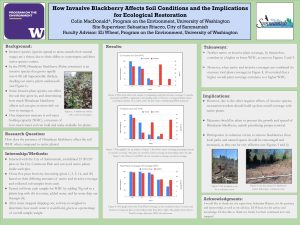How Invasive Blackberry Affects Soil Conditons and the Implications for Ecological Restoration
Himalayan blackberry is an invasive species in the Pacific northwest that takes over and outcompetes native plants. It’s very difficult to remove, and has spread all across western Washington. To determine the extent of its impact, I designed a study to see how Himalayan blackberry affects the surrounding soil. To accomplish this, I tested soil from five different plots, each featuring differing amounts of native plants and blackberry. I tested for soil water holding capacity (WHC), which is a measure of how much water the soil can hold and make available for plants. My study found that while Himalayan blackberry on its own didn’t affect soil WHC, a higher WHC was associated with a higher total plant presence, likely caused by a higher levels of organic material. This tells us that when working to restore a site ecologically, care should be taken to ensure that sites are well-populated with native plants, as they can change the soil to encourage more growth. Furthermore, more research is needed on Himalayan blackberry specifically and the dangers it poses to our environment.
